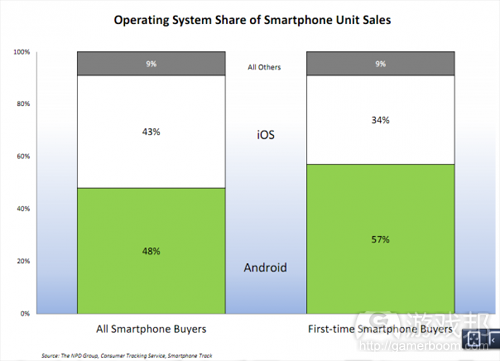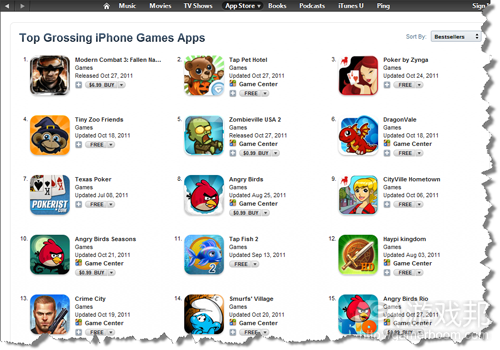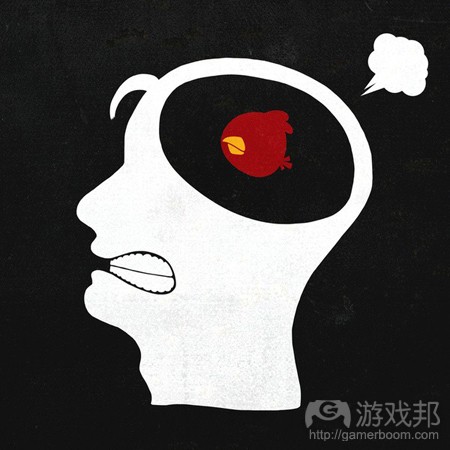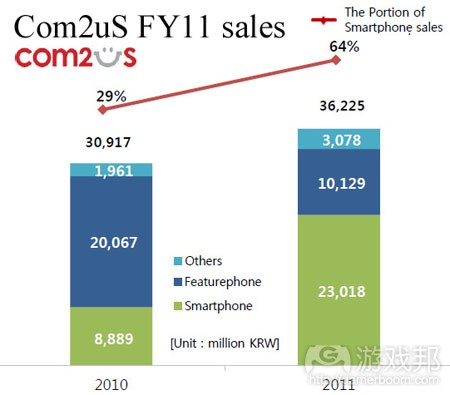每日观察:关注App Store或移除付费购买排名的应用(2.7)
1)NPD Group最新报告指出,苹果iPhone超越LG和三星成为美国2011年第四季度最畅销手机,但该时期多数新智能手机用户的首选却是Android移动设备。
苹果上个月宣布iPhone该季度销量已达3700万部,占据43%的智能手机市场份额,而Android则是48%。
但从新智能手机用户的情况来看,Android占比高达57%,而iPhone则是34%。
2)据Touch Arcade论坛匿名发贴者透露,有某公司正向开发者承诺收取5000美元就可将其应用“保送”至苹果App Store排行榜前列。
据称该公司可使用特定的程序多次下载开发者的应用,从而将其推将App Store排行榜前25名,助其收获大量曝光度。
该发贴者还进一步指出,Crowedstar(热门免费游戏《Top Girl》开发商)正在使用该服务,但后者联合创始人Suren Markosian立即回应称此事纯属子虚乌有,他们基本上是通过Flurry、Chartboos、iAd等合法渠道,花费大量营销成本推广游戏。
3)据苹果开发者渠道消息显示,苹果日前针对使用程序操纵App Store应用下载量的行为作出回应,声称若发现哪家工作室使用违规手段,App Store将直接移除其应用程序(游戏邦注:虽然苹果并未明确指出哪类违规做法,但从相关消息的时间巧合上可以看出苹果所指事件)。
4)Archives of Neurology最近发布论文显示,根据一项长达6年的调查研究显示,经常玩少激发大脑活跃性的游戏(例如脑力训练和益智游戏)可以增强人的记忆力,并且推迟或避免老年痴呆症。
该论文虽然没有特指哪款游戏,但论文作者及加州大学伯克利分校研究人员Susan Landau博士表示,这其中包括九宫格和《愤怒的小鸟》等游戏。
除此之外,调查还发现经常阅读、写作和玩游戏者大脑中的淀粉状朊(与老年痴呆症有关)含量更低。
5)韩国手机游戏发行商Com2uS发布的2011年(截止12月31日)财报告显示,公司业务销售额达362亿韩元(约3100万美元),同比增长17%;净收益达41亿韩元(约350万美元),增幅为0.1%.
智能手机游戏及IAP销售额占公司业务的64%(约2000万美元),而国际市场销售额占比49%(达1500万美元)。与此同时,公司功能性手机业务下降50%,共100亿韩元(860万美元)。
该公司计划在2012年发布44款Android游戏,43款iOS游戏(游戏邦注:2011年发布18款iOS游戏),多数游戏将由公司内部开发,但有15款则是来自第三方工作室的作品。
预计2012财年公司销售额将增长至546亿韩元(约4700万美元),增幅达50%;净收益将增长15%,达到47亿韩元(约400万美元),智能手机游戏销售额将占比88%,而国际市场销售额所占比例也将增长至67%。
6)MGI Research高级分析师Tero Kuittinen最近指出,Remedy公司移植到手机领域的《Death Rally》(原掌机版游戏于1996年问世)登陆iOS平台9个月已创收100万美元,而其营销成本仅1万美元,从中可以看出,中上级别的掌机游戏如果在手机平台找准了定位和价格模式,也很有可能大获成功。
据称《Death Rally》在App Store的发布售价为4.99美元,在FreeAppADay营销活动中的投入为5000美元,在RR活动中的投入也是5000美元,而该游戏仅需三天的收益就可收回开发成本。
该游戏后来降价为99美分,使其连续5天位居最畅销iPhone游戏榜单前列,并在80个地区的榜单中登顶。
IAP在该游戏收益中占比60%,其IAP类型包括单人模式中的游戏加速道具,以及多人模式中的可解琐汽车,这表明单人和多人模式用户对游戏收益均有重要贡献。(本文为游戏邦/gamerboom.com编译,拒绝任何不保留版权的转载,如需转载请联系:游戏邦)
1)iPhone tops US handset sales, Android attracts more newbies, says NPD
Devindra Hardawar
Corroborating what just about every other research firm has noted by this pointed, the NPD Group announced today in its latest report that the iPhone has become the best-selling handset in the U.S. during the fourth quarter.
No big surprises there, but the group also pointed out another interesting statistic: Despite the iPhone’s dominance, first-time smartphone buyers still overwhelmingly jump to Android.
In the fourth quarter, Apple overtook LG and Samsung with the iPhone 4S, iPhone 4, and iPhone 3GS, which all took the top three spots respectively in smartphone sales. Apple last month announced that it had sold a whopping 37 million iPhones during the quarter, thanks to the iPhone 4S launch and the holiday shopping frenzy. The iPhone accounted for 43 percent of smartphone purchases, compared to 48 percent for Android, according to NPD.
When it comes to smartphone newbies though, the figures look much different, with 57 percent going for Android and 34 percent going iPhone.
“Android has been criticized for offering a more complex user experience than its competitors, but the company’s wide carrier support and large app selection is appealing to new smartphone customers,” NPD’s Ross Rubin, executive director for Connected Intelligence, said in a statement today. “Android’s support of LTE at Verizon has also made it the exclusive choice for customers who want to take advantage of that carrier’s fastest network.”
I suspect Android’s big lead with newcomers is the availability of both cheap handsets and pre-paid phones. But with Apple’s low-end iPhone offering getting better every year (the iPhone 3GS is now free with contract), new smartphone buyers on a budget will likely begin to realize the iPhone is just as good a deal as a lesser Android handset.(source:venturebeat)
2)Developer claims unnamed company offering guaranteed top 25 App Store spots for $5,000
by Keith Andrew
Given Apple’s action against incentivised downloads platforms in the past, the suggestion studios can now actively buy a spot in the App Store’s top 25 rankings will make grim reading for
those at the firm’s Cupertino HQ.
An annoymous poster on Touch Arcade’s forums has alleged an unnamed company is offering developers a guaranteed route to the top of the App Store’s charts for $5,000.
It’s claimed the company in question utilises bots that downloads a developer’s app several times until it breaks into the top 25, gaining the game in question a whole host of exposure in the process.
Crowding out the market
Though details are sketchy, a further source has told Pocket Gamer the story has merit, with the outfit having also been approached by a company that pitched a similar offer to the one outlined on Touch Arcade.
Going further, the anonymous poster went on to claim Crowdstar – the studio behind recent female-focused freemium hit Top Girl – had already utilised the service.
It’s an allegation Crowdstar co-founder Suren Markosian naturally took issue with.
“We all spend hundreds of thousands if not millions promoting our games every month using legitimate advertising channels such as Flurry, Chartboost, iAd, etc,” he said.
“While I sympathise with the smaller developers who may not have as much funding as we do and feel that we are getting a free ride the fact is we are spending significant marketing dollars to achieve top ratings.”(source:pocketgamer)
3)Apple offers official warning to App Store ‘manipulators’
by Keith Andrew
The suggestion that third party companies have been utilising ‘bot farming’ techniques to offer developers guaranteed spots within the higher echelons of the App Store’s rankings was never likely to go down well with Apple, and indeed the company hasn’t been slow in offering an official response.
Via a short post on Apple’s developer channel, the Cupertino giant has fired an official shot across the bows of studios making use of such services, threatening to remove them from the
App Store entirely if found guilty.
Out of the club
“Once you build a great app, you want everyone to know about it,” opens the entry.
“However, when you promote your app, you should avoid using services that advertise or guarantee top placement in App Store charts.
“Even if you are not personally engaged in manipulating App Store chart rankings or user reviews, employing services that do so on your behalf may result in the loss of your Apple
Developer Program membership.”
No exact reference is made to the supposed bot farming technique, though the timing of the post is unlikely to be a coincidence.
Battle of the bots
Attention was first drawn to the issue after an anonymous developer revealed an unnamed company had been offering studios a spot in the App Store’s top 25 rankings for $5,000.
The process utilises bots that download a developer’s apps several times until it secures a top spot in the platform’s charts.
The original company behind the outed technique remains anonymous, though Pocket Gamer has since learned from several sources that more than one firm may be offering these services and
that several leading developers are taking advantage of them.
Suffice to say, most parties are likely to cut back on these practises relatively sharply for fear of incurring Apple’s wrath, so the App Store rankings should make interesting viewing in the week ahead.(source:pocketgamer)
4)Study: Got Angry Birds on the brain? You might be better off that way
by Joe Osborne
You keep doing you, Angry Birds addicts. According to a nearly six-year study released by the Archives of Neurology, playing mentally-stimulating games (like brain trainers and puzzle games) can improve memory and delay or prevent Alzheimer’s disease. The study doesn’t mention any games in specific, but University of California-Berkeley researcher and study author Dr. Susan Landau told ABC News that game playing can range from Sudoku to Angry Birds and more.
The study observed the presence of a certain protein, amyloid (often linked to Alzheimer’s), in the brains of 65 people with an average age of 76, 10 Alzheimer’s patients with aged 74 on average and 11 young controls with an average age of 24. “There was no emphasis on what games were played, but just at what age and how often people were participating in brain stimulating activities, including reading, writing, and games,” Landau told ABC.
Ultimately, the study found that those who did more reading, writing and gaming over their lifetime show less amyloid in their brains, and thus perhaps a lower chance of developing Alzheimer’s. If you ask folks like 100-year-old Kit Connell, games like this are vital to keeping sharp. And that, friends, is a fine excuse for flinging one last Angry Bird at the dinner table. You’re welcome.(source:games)
5)Boosted by rising overseas smartphone market, Com2uS sees FY11 sales up 17% to $31 million
by Jon Jordan
Korean mobile game publisher Com2uS (KOSDAQ: 078340) has announced its financial results for FY2011, the twelve months ending December 31.
Sales were 36.2 billion Won (around $31 million), up 17 percent year-on-year.
Net income was 4.1 billion Won ($3.5 million), up 0.1 percent.
The reason for the static profits was a rise in operating expenses, up 16 percent year-on-year as Com2uS increased staff numbers, marketing and service fees.
Getting smarter
In terms of the company’s sales growth, the major source was the sale of smartphone games and in-app purchases.
This part of the business grew 159 percent year-on-year to 23 billion Won (around $20 million).
It accounted for 64 percent of sales during the year.
Going global
In November, the Korean version of the Apple App Store opened a dedicated games category for the first time.
However, the majority of smartphone growth came from international markets, with the share of overseas sales climbing to 49 percent (worth 17.6 billion Won, or $15 million).
This is up from 28 percent during FY2010.
The company pointed to the success of games such as Homerun Battle 2, Tower Defense, 9innings and Tiny Farm is key drivers.
During the year, Com2uS’ feature phone business dropped 50 percent to 10 billion Won ($8.6 million).
Indeed, as most of such sales are from Korea, Com2uS’ domestic sales dropped 16 percent to 18.6 billion Won ($16 million).(source:pocketgamer)
On the back of encouraging FY2011 sales figures, Korean mobile publisher Com2uS has set out an aggressive plan for 2012.
Having successfully transitioned its business from a domestically-focused feature phone business, sales of smartphone games now make up 64 percent of its business, while international sales accounted for 49 percent of sales in 2011.
Both elements are rising fast too.
Big bang
Taking advantage of the situation, Com2uS is looking to expand both parts of its business.
During 2012, it plans to release 44 Android games and 43 iOS games. During 2011, it released 18 iOS games, so this is a considerable increase.
Most of these titles will be developed in-house, but around 15 will be sourced from third party studios.
And more than half of them will be social freemium games; an area in which Com2uS hasn’t been particularly active. Its first launch was Tiny Farm in August.
Smarter, global
On this basis, it expects FY2012 sales to be 54.6 billion Won (around $47 million), up 50 percent, with net income up 15 percent to 4.7 billion Won ($4 million).
It estimates smartphone sales will make up 88 percent of this total, while the share of international sales will be 67 percent.(source:pocketgamer)
6)Remedy’s $1 million Death Rally success example of revenue console devs can accrue on iOS, reckons analyst
by Matt Sakuraoka-Gilman
With more and more console studios making a splash on smartphones, MGI Research senior analyst Tero Kuittinen’s move to define the reasons behind the success of Remedy’s Death Rally on iOS was always likely to garner interest.
Despite having a background in big budget console releases for major third parties – Alan Wake and Max Payne to name a couple – Remedy was able to evolve Death Rally into a $1 million hit on iOS over a nine month period.
Most interestingly, all this was achieved with a marketing budget of just $10,000.
Kuittenen argues that the release highlights a growing trend in the games industry, whereby established middle-hitters in the console arena have begun exploring new strategies and pricing models in the mobile market.
The price is right
In an eight point scale designed to detail the factors behind the game’s success for Forbes, Kuittinen begins by pointing out Death Really launched on the App Store for the high price of $4.99.
“Remedy priced it high, but spent only nominally on marketing – $5,000 on a FreeAppADay campaign, $5,000 on a tightly focused PR initiative,” offers Kuittinen, before pointing out the game recouped Remedy’s development costs in three days as a result.
“Modest early marketing spending can trigger a snowball effect if the game is appealing. Getting Apple to feature the game is a bigger boost than any ad campaign.”
Dropping the price down to 99c resulted in the game becoming the best selling iPhone game across the globe for five days, topping the charts in 80 individual territories in the process.
In Kuittinen’s view, Death Rally’s initial high price gave the game an “exclusive sheen”.
IAP up
In-app purchases (IAPs) have also a key revenue driver: Death Rally amasses 60 percent of its revenue from IAPs, with that revenue split in half between so-called ‘experience speed-ups’ in single player mode, and unlockable vehicles in multiplayer.
“This implies that catering to both single-player and multiplayer audiences is important for maximizing revenue generation,” said Kuittinen.
Further to this, giving away the game for free during the European ‘Midsummer weekend holiday’ saw downloads jump by 2 million – any loss of revenue incurred from giving the game away made up by a surge in IAPs.
“Giving the game away can boost sales, but it’s not an easy trick to pull off,” admitted Kuittinen.
“It may not be the best option for all games, at least during the early months. It requires an intricate and well-balanced framework of in-game shopping features.”
And Android
Expanding beyond Death Rally, Kuittinen also suggests that, on average, Android games make about 30 percent of the revenue that iPhone games do – though, naturally, this isn’t always the case.
“Some Android titles eke out [a] mere 10 percent of the iPhone version revenue, some actually generate more,” he said.
“Much depends on how the vendor handles the tricky task of juggling in-game purchases.
“Android games can exploit the so-called ‘offer wall’ option, where consumers can download a free game if they opt to also download certain other applications.”
Grim future for handhelds?
But Kuittinen’s main point is that, though Death Rally arguably had a head start (the game was based on an existing franchise from 1996), mid-range console developers can deliver fast earning content on smartphones if they deploy their apps in the right way.
“Recouping development costs in three days is something that is hard to pull off in the console world,” added Kuittinen.
“Cutting off distributors and minimising marketing spending holds powerful appeal. The risk/reward ratio of mobile phone games is starting to suck in console game developers.
“What this means for portable console vendors like Sony PS Vita and Nintendo 3DS is likely to become clear over the next 24 months.”(source:pocketgamer)












































 闽公网安备35020302001549号
闽公网安备35020302001549号